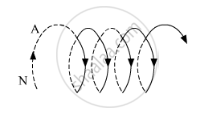Advertisements
Advertisements
प्रश्न
Derive the expression for the magnetic field due to a solenoid of length ‘2l’, radius ‘a’ having ’n’ number of turns per unit length and carrying a steady current ‘I’ at a point
on the axial line, distance ‘r’ from the centre of the solenoid. How does this expression compare with the axial magnetic field due to a bar magnet of magnetic moment ‘m’?
उत्तर
Consider a solenoid of length 2l, radius a and having n turns per unit length. It is carrying a current I.
We have to evaluate the axial field at a point P at a distance r from the centre of the solenoid

Consider a circular element of thickness dx of the solenoid at a distance x from its centre.
The magnitude of the field due to this circular loop carrying a current I is given as
`dB=(mu_0dxnIa^2)/(2[(r-x)^2+a^2]^(3/2))`
The magnitude of the total field is obtained by integrating over all the elements from x = −l to x = +l.
`B=(mu_0nIa^2)/2int_(-1)^(+1)dx/(2[(r-x)^2+a^2]^(3/2))`
Consider the far axial field of the solenoid, so r ≫a and r≫l. Hence, we have
[(r-x)2+a2]3/2 ≈ r3
So, we get
`B=(mu_0nIa^2)/(2r^3)int_(-1)^(+1)dx`
`B=(mu_0nIa^2)/(2r^3)2l`
The magnitude of the magnetic moment of the solenoid is
m Total number of turns current cross-sectional area
m=(nx2l)xIx(πa2)
Therefore, we get the magnetic field as
`B=(mu_0)/(4pi) (2m)/r^3`
This is the expression for magnetic field due to a solenoid on the axial line at a distance r from the centre.
This magnetic field is also the field due to a bar magnet of magnetic moment m.
APPEARS IN
संबंधित प्रश्न
An observer to the left of a solenoid of N turns each of cross section area 'A' observes that a steady current I in it flows in the clockwise direction. Depict the magnetic field lines due to the solenoid specifying its polarity and show that it acts as a bar magnet of magnetic moment m = NIA.

A wire AB is carrying a steady current of 6 A and is lying on the table. Another wire CD carrying 4 A is held directly above AB at a height of 1 mm. Find the mass per unit length of the wire CD so that it remains suspended at its position when left free. Give the direction of the current flowing in CD with respect to that in AB. [Take the value of g = 10 ms−2]
Define mutual inductance between two long coaxial solenoids. Find out the expression for the mutual inductance of inner solenoid of length l having the radius r1 and the number of turns n1 per unit length due to the second outer solenoid of same length and r2 number of turns per unit length.
Draw and compare the pattern of the magnetic field lines in the two cases ?
The magnetic field inside a tightly wound, long solenoid is B = µ0 ni. It suggests that the field does not depend on the total length of the solenoid, and hence if we add more loops at the ends of a solenoid the field should not increase. Explain qualitatively why the extra-added loops do not have a considerable effect on the field inside the solenoid.
A long solenoid of radius 2 cm has 100 turns/cm and carries a current of 5 A. A coil of radius 1 cm having 100 turns and a total resistance of 20 Ω is placed inside the solenoid coaxially. The coil is connected to a galvanometer. If the current in the solenoid is reversed in direction, find the charge flown through the galvanometer.
The magnetic field B inside a long solenoid, carrying a current of 5.00 A, is 3.14 × 10−2 T. Find the number of turns per unit length of the solenoid.
A long solenoid is fabricated by closely winding a wire of radius 0.5 mm over a cylindrical nonmagnetic frame so that the successive turns nearly touch each other. What would be the magnetic field B at the centre of the solenoid if it carries a current of 5 A?
A current of 1.0 A is established in a tightly wound solenoid of radius 2 cm having 1000 turns/metre. Find the magnetic energy stored in each metre of the solenoid.
A long solenoid carrying a current produces a magnetic field B along its axis. If the current is doubled and the number of turns per cm is halved, the new value of magnetic field will be equal to ______.
